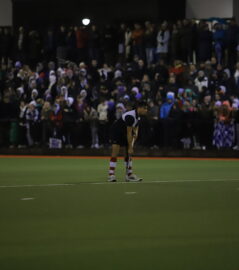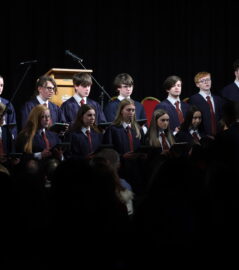I have been asked a number of times about our school’s deployment of EyeTV and the role it plays in teaching and learning. We have been using Elgato’s EyeTV for recording our film and television programmes for about three years now and this service is further offered to around ninety teachers. The use of TV in teaching isn’t anything new and many departments have amassed dozens of VHS tapes over the years.

Moving to a digital recording system was a planned and considered process. Initially we started off with a single Elgato adaptor and an internal digital aerial. Although this was successful with the main channels a number of the digital channels couldn’t be record reliably.
After two or three months of working with the internal antenna that wasn’t terribly reliably for the latter end of the spectrum we moved to have an external aerial installed. This revolutionised the system and its usefulness for teachers by not only making all channels recordable but we discovered one or two new channels we couldn’t access with the internal solution.
Initially we recorded programmes and exported them in iPod format directly to iTunes. This single iTunes library was then shared (with a password) to all computers on the network. Teachers would then use iTunes to present the shared media.
This was relatively successful but problems arose with managing and deploying iTunes across the proxied network. This resulted in us moving away from this method of sharing the recorded TV and back to offering teachers their recorded TV on DVD or in Mp4 format.
On the occasions when a series of programmes is recorded departments tend to opt for a DVD of the series rather than single Mp4 files. Roxio Toast 10 is fully supported my EyeTV and offers the easiest and quickest way to make a compilation DVD. EyeTV 3 makes series recording a programme a 1 click process.
As the service grew in popularity we had occasions when two programme schedules clashed. At this point we upgraded to the Elgato Diversity (dual tuner device). This allows two programmes to be recorded at once without issue. I would make sure you check your signal strength before deploying dual tuners as the signal is obviously shared across the two recording adaptors.
Teachers request TV recordings via the ICT helpdesk with as much notice as possible but on a few occasions useful programmes have been discovered within hours of broadcast. When this happens one of the ICT team can login to our TVTV account and remote schedule the recording. TVTV is the company who provide the EPG (Programme Guide) within the EyeTV Application). A year’s subscription comes with EyeTV on purchase but the service is very affordable at only £15 pounds per year.
The school EyeTV install is set to check the remote TVTV schedule (on the TVTV site) periodically, if you are going to use the remote schedule then it is definitely worth setting EyeTV to check this as often as possible. To date there has only been one or two times when we missed a recording via leaving the remote schedule too late.
Despite trying EyeTV’s wifi share and sharing iTunes we have found recording and exporting footage out to departmental shared areas the best solution for everyday use. Not only does this keep the Mac recording the programmes free from archived recordings but it also pushes the responsibility for the recording over to the department.
Each department has their own network share on a NAS server and within this is a read only folder entitled “Media”. The encoded video is placed in this media folder as soon as it is converted.
We initially set the automation of conversion on completion of the recording but over time we have refined the process and a member of staff proudly removes ads, and trims the start and end of the recordings before conversion.
The trimming and conversion although a daily routine is a very quick and easy process. Although not essential it is appreciated by teachers who don’t have to ‘fast forward’ through ads to get to the footage they require. Trimming and removing Ad breaks is simple with EyeTV so we can really reduce programmes down or better simply export the clip needed by the teacher for a lesson.
As well as offering the ability to remove ads and trim the start and end of recorded programmes EyeTV’s powerful editing offers the ability to export clips from programmes or films. Quite often (and particularly for subjects like Moving Image Arts) the teacher doesn’t necessarily need the entire programme but a snippet from within the recording. Working with the teacher it is really easy to isolate the required section of the programme and export this footage as an independent clip.
We try to cater for whatever format the teacher needs the footage in. Some require a small clip in Quicktime/mp4 web ready format for use on the Virtual Learning Environment. Some ask for the footage to be iPod ready so the students can use it as revision while others want the full series / documentary on DVD.
Our aim is to move to a completely ICT based media solution. Most departments have shelves of VHS videos that are still an active part of teaching and learning. We hope that the EyeTV system will see the phasing out of VHS and for those tapes that are considered gems of learning we plan to use the Elgato video capture device to convert these to mp4.
The EyeTV recording system has grown in popularity across most departments. The system is simple to use and the output is spectacular. It just works ! Editing is simple and exporting is quick (especially with the Turbo.264 devices) We can record, convert and use a clip during a class within hours of broadcast and the mp4 format means recording footage looks brilliant displayed on the classroom data projectors.
Having embarked on a digital recording service for teachers there is no way we could go back to traditional tape or even direct DVD recording. With the number of pupil owned iPhone and iPods around digital learning resources in MP4 format will be as commonplace as PowerPoint in the next few years.
The only limitations we have seen are that some teachers expect the full compliment of satellite programmes to be available but with the rumour of Freesat support just around the corner the system will become even more useful in the months ahead.
1. Use an external aerial.
2. If you plan to burn DVDs invest in Roxio Toast.
3. If you plan to export the majority of your footage to MP4 (H.264) then definitely consider the Turbo.264 or Turbo.264 HD)
4. Use the TVTV remote schedule system and set it to pole as the TVTV site as often as possible.
5. Offer section exports, this saves on disk space for stored recordings.
6. Convert archived VHS tapes with the Elgato video Capture device.
Last modified: February 15, 2010









